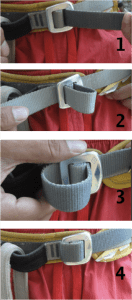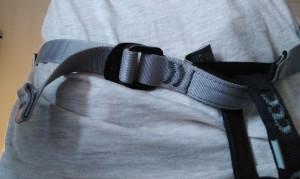I was reminded of this very important point for trip leaders, as well as every person and their own harness, while leading Fortress Canyon with Dion last weekend.
While I was putting someone on abseil for the 5m drop and going through the safety checks, i.e. checking that her descender and carabiner were set up correctly (through the belay loop and not anywhere else which is another story) and that she could weight the rope, she asked me “Is my harness tight enough”. I could see that it was, but it reminded me to double check her harness buckle and Lo and behold! I would have been sending her down with just the friction of a half done up harness to hold her body weight. Now I’ve heard it can hold (like it did while she was testing weighting the rope) but of course, you wouldn’t bet your life on it. I’m very glad she reminded me and the thought of what might’ve happened has prompted me to write this to make sure it doesn’t happen to you.
It is very easy for a non-doubled back harness to go unnoticed and this can of course lead to very serious consequences. If you’re not sure what I mean by doubled back see the below image which details how to properly fasten and double back this type of harness buckle (click for larger).
Now these days, most harnesses have fool-proof permanently doubled back buckles like my one here (also note the thick stitching at the end which prevents it coming back through the buckle):
This is great really, except that people are forgetting or not learning that the former type of buckle still exists (it's basically every club harness) and hence that a harness buckle should always be double checked before every climb, abseil or belay along with checking knots, belay devices, weighting the rope etc. etc. So please, stay safe and make sure you do!
As a another example I saw an even closer call on a climbing trip a few years ago. A relatively experienced climber had borrowed someone else's harness and hadn’t realised it needed to be doubled back. While lowering a top roper down she felt the harness begin to loosen and pull away as the harness strap slid through the buckle. Luckily, she responded well and called for help while stopping the lower and grabbing the rope both above and below the device to control and weight it. The trip leader came quickly and grabbed and hung off the rope as well before calling me (who hadn’t noticed a thing) over to put the dead end on belay. I did this asap, seeing something was up, before safely lowering my friend down the 20m he still had to go.
So there you go, it is an easy mistake to make so please always double back and double check your own harness as well as those of who you’re with.
Cheers, Brendan





